We all know that breaking into someone’s house is illegal in the real world. Digital world is no different: intruding into users’ inboxes without permission is a bad practice as well. When it comes to having a class-A reputation and high email performance, engaged audience is the key. So, if you want to shape an interested and engaged audience, permission-based email marketing is a must for you. In this article, we’ll take a look at its benefits and the ways to do it right.
Content:
What is permission-based email marketing?
Permission-based email marketing, or simply permission email marketing, or also opt-in email marketing, is what it sounds like — an approach based on a marketer’s being allowed to send emails to subscribers. This means you get permission to add the subscriber to your mailing list and include their address to your future campaigns.
Permission is usually classified into two types:
- Implicit — based exclusively on the assumption that a user agrees to receive emails due to their previous interactions with the company, for example, registration of an account, purchase of a product or service, exchange of business cards, and so on.
- Explicit — based on an expressed consent to receive emails a user gives by entering their email address in a subscription form on a website.
Non-permission based email marketing, on the contrary, is based on the lack of subscribers’ consent to receive emails. This commonly happens when email marketers use a purchased mailing list of contacts who never agreed to hear from them or simply parse email addresses from social media or other websites.
Benefits of permission-based email marketing
Permission in email marketing not only provides you with explicit consent to email your recipients but also
- Keeps your emails away from spam folders. When the users are familiar with the sender, they won’t flag the incoming emails as spam. On top of that, it makes you GDPR-compliant, because you only store and process subscribers personal data with their consent.
- Boosts conversions rate. Users who deliberately agreed to hear from you are more likely to open your emails and click the links you send.
- Allows sending personalized content. You can have the best of both worlds if, during the subscription stage, you ask users not only for permission to email them, but also about the content they are interested in. This way, you’ll be able to target your subscribers with information they find useful.
- Improves your brand reputation. Permission-based relationship with subscribers shows that you know who is on your mailing list, care about your subscribers’ privacy, keep your database clean, and don’t pull email addresses from various websites.
How to do permission email marketing
Here is a checklist on how to grow an opted-in mailing list:
Use subscription forms on your website
Brands typically place the subscription form in the footer of their websites, and Kate Spade also follow this rule. They motivate the users to join the company’s mailing list by offering a discount for the first order.
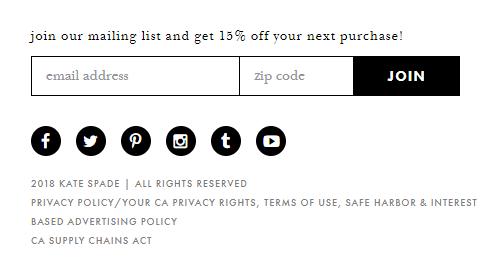
With SendPulse, you can create four types of subscription forms: embedded, pop-up, floating, and fixed. Moreover, you can shape the form up to your needs by adding a drop-down list to it:
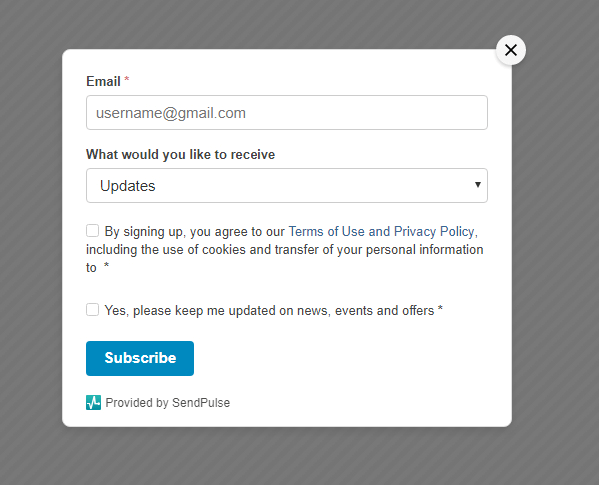
Use double opt-in
The double opt-in method presupposes sending a confirmation email after the user signs up to your campaigns. By clicking the link in the email, the user will confirm they want to hear from a particular company.
Below is an example of a two-step subscription form from Bershka. First, the users fill in the subscription form on the company’s website. Second, a pop-up window appears and the users choose whether they are interested in female or male content.
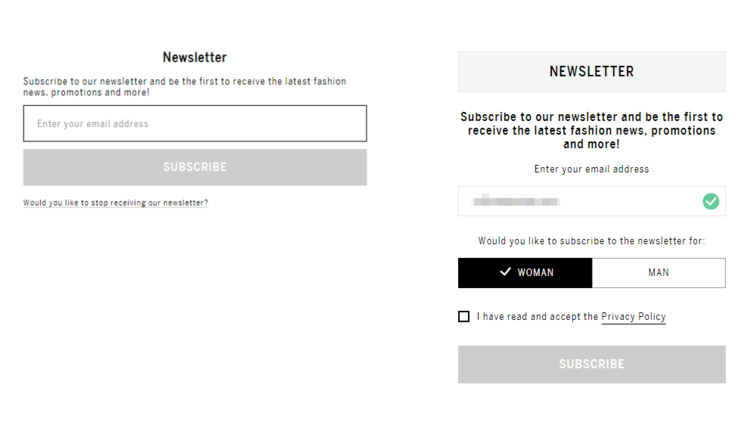
After that, the brand sends a confirmation email notifying what information users are subscribing to.
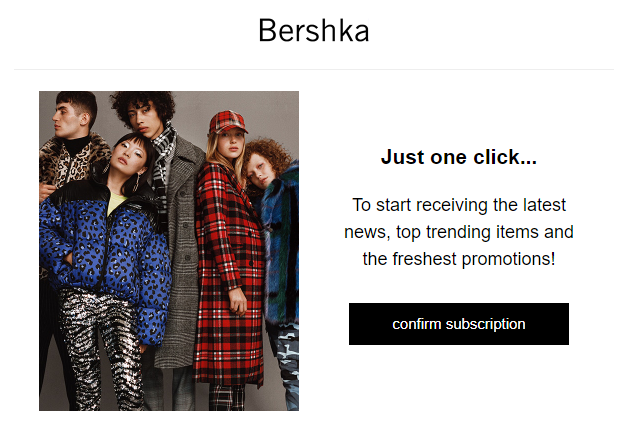
Allow subscribers to manage preferences
The fact of obtaining users’ addresses doesn’t mean you can email whatever and whenever you want. Let users have a say and decide when they want to receive your emails. Place the link to a preference center in the footer of the email. By clicking it, the user will be referred to your website where they will choose the preferable time and content for your campaigns.
For example, in their preference center, Forever 21 offer to choose the frequency of emails to come up with essential offers: daily, weekly, monthly.
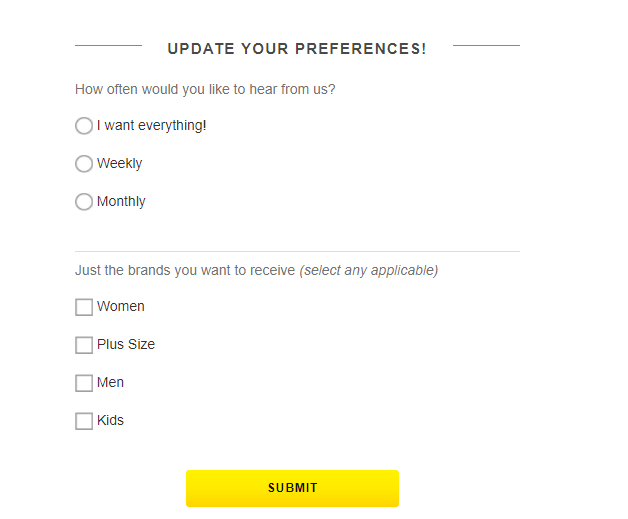
Make it easy to unsubscribe
Being allowed to send emails to users isn’t the final whistle in this permission-getting game. You also need to enable your audience to unsubscribe if they decide to. This way, you’ll reduce the probability of being flagged as spam for sending unwanted content even after you obtain the desirable email permission.
True Citrus knows this rule well: they place the unsubscribe link to the footer of each email they send.
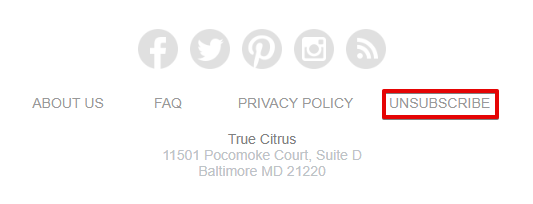
After a user clicks this link, they are redirected to the page with two options: unsubscribe for good or stay on the company’s mailing list but indicate preferable topics for future emails.
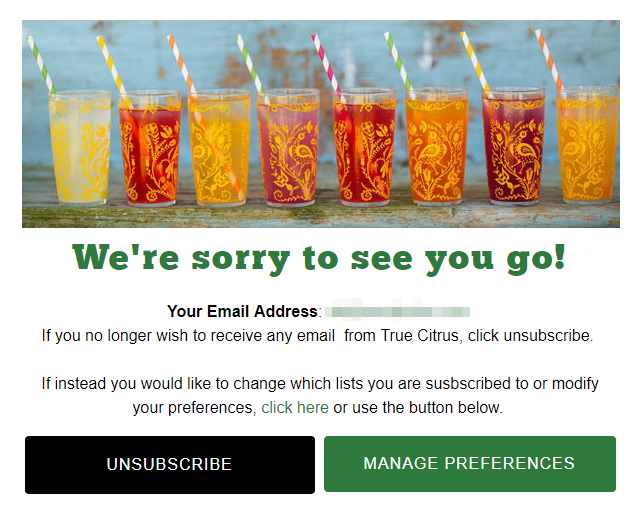
Endnotes
Permission-based email marketing is all about respecting your subscribers and following the rules. As a fair player, you’ll get an array of benefits represented by high open, click-through and deliverability rates, engaged subscribers, and good reputation, of course.
To build a proper permission email marketing strategy, follow these tips:
- To stay away from spam folders and keep a trustworthy sender reputation, never buy a database; instead, ask users to subscribe through subscription forms on your website.
- Use a double opt-in subscription method to get explicit permission from users to send them email campaigns.
- Let subscribers manage their preferences for you to come up with relevant offers.
- Provide users with an unsubscribe link in every email so that they can opt out easily; make the unsubscribe process as effortless as possible.
Remember to shape your database and send email campaigns with SendPulse. Good luck!





